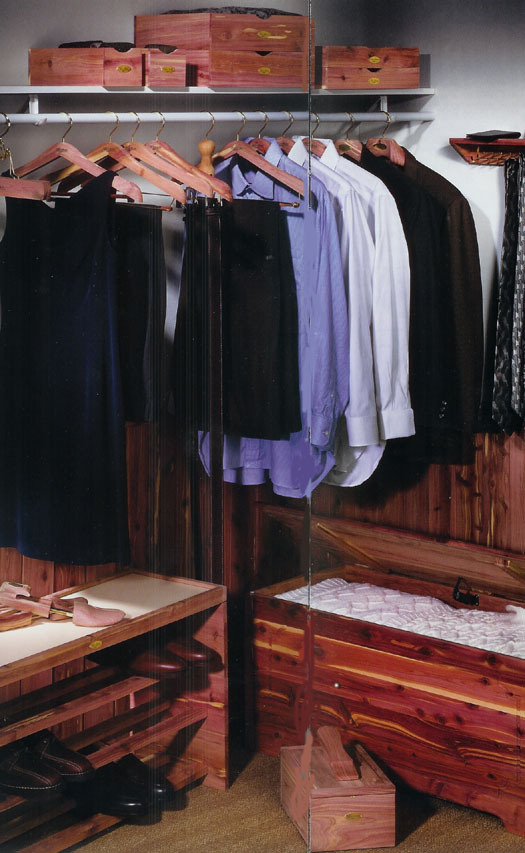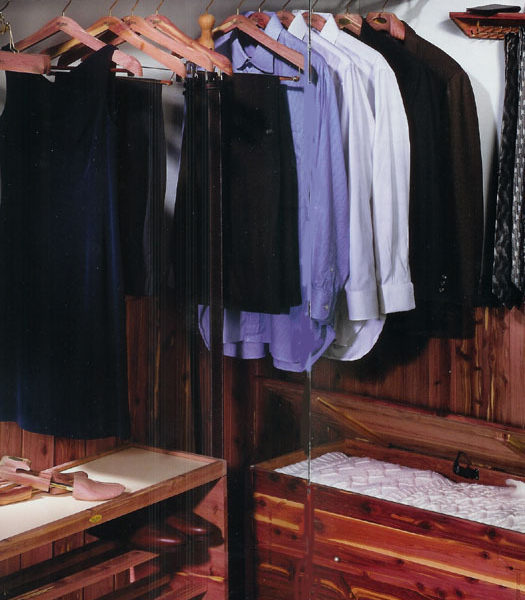
Men often email me to ask how to store their clothes, so I thought I’d offer a few simple best practices for most of the clothes in your closet. If you’re looking for information on seasonal clothing storage – like putting away winter coats in summer, read the great article Derek wrote a few months ago.
Remember that animal fibers (especially wool) can attract moths. Wherever you store your clothes should have some ventilation and be dry. Keep your wool clothing clean (moths like moisture and especially food stains). Some strong smells, like cedar, will discourage moths from setting up shop, though only mothballs will kill them.
Shoes: With shoe trees, preferably wooden. “Lasted” trees (trees in the exact form of the shoe) are best, but not necessary. Try buying trees for about $12 at your local Nordstrom Rack, or keep an eye out for pairs for about $3 at your local thrift stores. Shoe bags (usually made of cotton flannel) recommended when traveling, or for shoes that are likely to get dusty, like velvet slippers.
Socks & Underwear: In a drawer. Cedar smells nice. I actually store mine in an old aluminum cooler that has a few lavender sachets in it.
Shirts: Folded or hung from a hanger. Button the collar to maintain its shape and another button further down the shirt front to keep them from flapping around. A slimline hanger is fine for shirts, but don’t use wire. You’re not an animal.
T-Shirts & Polo Shirts: The thin cotton of polos can stretch if hung. Fold and stack them.
Suits & Sportcoats: Suits and sportcoats should be hung. At the least you should hang them from a hanger with some shape (a traditional suit hanger which bends forward slightly, rather than the straight plastic five-for-three-dollars hangers from the dime store). It’s even better to hang them from hangers with some width in the shoulder. You want something that supports the full shoulder pad, shaped not unlike your own shoulder. This keeps the shoulder of the coat from deforming. Wood is more attractive, but plastic will also work fine here (and is lighter weight). These usually only come with very high-end suits, but they can be purchased new, and most of mine came from estate sales. Decent suit hangers were apparently much more common thirty or forty years ago.
Trousers: I like felted clamp hangers, clamped onto the hem of the trousers, if you have the room. This helps wrinkles fall out. Hanging them on traditional trouser bars is perfectly fine, though. Look for bars with felt (best) or rubber (OK) coverings to prevent slippage.
Casual Pants: I fold my pants which don’t take a crease – blue jeans and chinos, primarily. Some denim enthusiasts hang their jeans from a hook rather than fold them to protect their wear patterns, but that’s further than I’m willing to go.
Belts: Rolled or hung from their buckles.
Ties: Rolled or hung, untied. If you’re lucky enough to have a fancy closet, you may have shallow drawers with dividers appropriate for rolled ties. If so: God bless. I’ve hung my ties for many, many years and they’ve suffered no apparent ill effects. Mine hang from a rack that was once designed to be used with clips to hang baseball caps. It’s a series of horizontal bars. You could get the same effect with a freezer rack hung on a wall. There are also plenty of tie hangers in the shape of coat hangers.
Handkerchiefs & Pocket Squares: These can be hung from clips on a rotating rack if you’re really fancy, but I just fold mine. A cedar box is nice, but you can also use clear plastic shoe boxes so you can easily spot your favorite.
Sweaters & Knits: Never, ever hang sweaters on coat hangers. Fold them. Hanging them will mess them up, especially over time (but even in a few hours for heavier pieces). Even if you think of that cardigan as “coat-like,” it should still be folded, not hung.
Hats: Hook ‘em! Or put them in hat boxes. And remember they can be a moth target, too.
Sweatpants: I recommend storing these in the garage, in a box marked “Salvation Army.”
